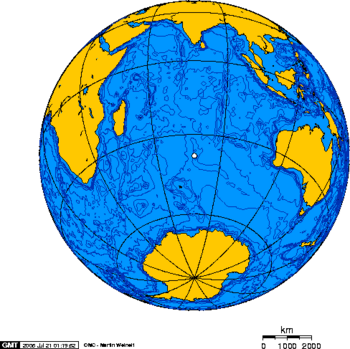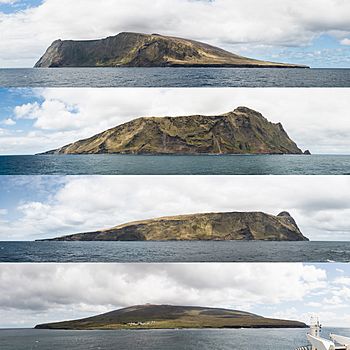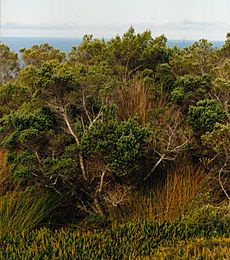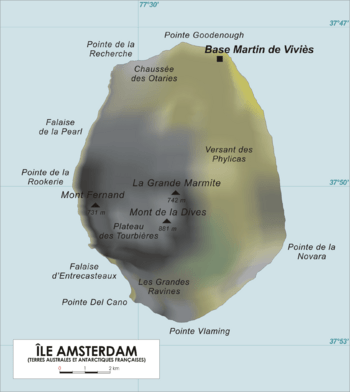Île Amsterdam facts for kids
Quick facts for kids
Amsterdam Island
(New Amsterdam) Île Amsterdam (French)
|
|
|---|---|
|
Flag
|
|
|
Motto: "Liberté, égalité, fraternité"
|
|
|
Anthem: La Marseillaise
|
|

Orthographic projection centred over Île Amsterdam.
|
|
| Government | District of French Southern and Antarctic Lands |
Île Amsterdam, also called Amsterdam Island or New Amsterdam, is a small island in the southern Indian Ocean. It is part of the French Southern and Antarctic Lands. This territory is made up of five districts, and Amsterdam Island is one of them. It is located about 90 kilometers (56 miles) north of another island called Île Saint-Paul.
The island is almost the same distance from Madagascar, Australia, and Antarctica. It is also about 3,200 kilometers (2,000 miles) from the British Indian Ocean Territory and the Cocos (Keeling) Islands.
The only place where people live on the island is a research station called Martin-de-Viviès. It was first known as Camp Heurtin. About 30 researchers and staff live there during certain times of the year. They study things like biology, weather, and the Earth's magnetic field.
Contents
Island History
The first person known to see Amsterdam Island was a Spanish explorer named Juan Sebastián de Elcano. He saw it on March 18, 1522, while sailing around the world. Elcano named it Desesperanza, which means "Despair." He chose this name because he could not find a safe place to land. His crew was also very thirsty after sailing for 40 days from Timor.
On June 17, 1633, a Dutch sailor named Anthonie van Diemen saw the island. He named it Nieuw Amsterdam after his ship. The first time someone landed on the island was in December 1696. This landing was led by the Dutch explorer Willem de Vlamingh.
A French sailor, Pierre François Péron, wrote that he was left alone on the island between 1792 and 1795. His book, Memoires, describes his experiences. However, people often confused Île Amsterdam and Île Saint-Paul back then. So, Péron might have been on Saint-Paul instead.
Early Visitors and Shipwrecks
People who hunted seals landed on the island for the first time in 1789. Between that year and 1876, 47 sealing ships visited the island. Nine of these ships were wrecked there. You can still find old items from the sealing days on the island.
In 1793, the island was a stop for the Macartney Mission. This was a British trip to China.
On October 11, 1833, a British ship called Lady Munro was wrecked at the island. There were 97 people on board. Two weeks later, a US sealing ship, General Jackson, rescued 21 survivors.
In November 1838, John Balleny visited the island. He was in charge of a ship called Eliza Scott, which was used for exploring and sealing. He was looking for seals. He came back with some fish and said he saw the remains of a hut and a whale carcass.
French Claims and Settlement Attempts
France first claimed Île Amsterdam and Île Saint-Paul in June 1843. A rule from June 8, 1843, told a Polish captain named Adam Mieroslawski to take control of both islands for France. Records from his ship, the Olympe, show that he took possession of the islands on July 1 and 3, 1843. These records are still kept today. However, the French government later gave up its claim to the islands in 1853.
In January 1871, a group led by Heurtin, a Frenchman from Réunion, tried to settle on the island. They tried to raise cattle and grow crops. But after seven months, their efforts failed. They went back to Réunion and left the cattle on the island.
In May 1880, a British ship, HMS Raleigh, sailed around the island. They were looking for a missing ship called the Knowsley Hall. Sailors from the Raleigh went ashore to look for signs of people. They found a flagpole and two huts. One hut had a roof and contained beds, empty barrels, an iron pot, and bird remains. The other hut had an upside-down boat, likely belonging to fishermen.
In 1892, the crew of a French ship called Bourdonnais again claimed Saint-Paul and Amsterdam Island for France. Another ship, L'Eure, did the same in 1893.
The island was part of the French colony of Madagascar from 1924 until 1955. Then, the French Southern and Antarctic Lands were created. Madagascar became independent in 1958.
The first French base on Île Amsterdam was built in 1949. It was first called Camp Heurtin. Today, it is the Martin-de-Viviès research station. The Global Atmosphere Watch, which studies the Earth's atmosphere, still has a presence on Île Amsterdam.
Amateur Radio on the Island
From 1987 to 1998, many amateur radio operators worked from Amsterdam Island. Amateur radio is a hobby where people use radio equipment to talk to others around the world. In the 1950s, there was a resident amateur radio operator using the callsign FB8ZZ.
In January 2014, Amsterdam and St Paul Islands were listed as one of the most wanted places for amateur radio contacts. On January 25, 2014, a group of amateur radio operators landed on Amsterdam Island. They used the callsign FT5ZM and made over 170,000 radio contacts worldwide. They stayed active until February 12.
Island Environment
Geography of Amsterdam Island
Amsterdam Island is a volcanic island. It is a potentially active volcano, meaning it could erupt again. We don't know of any eruptions in recent history. However, the newest volcano features suggest an eruption might have happened about a century ago.
The island covers an area of about 55 square kilometers (21 square miles). It is about 10 kilometers (6 miles) long at its longest point. The highest point is Mont de la Dives, which is 867 meters (2,844 feet) high. The high central part of the island is over 500 meters (1,640 feet) high. This area is called the Plateau des Tourbières, or "Plateau of Bogs." The western coast has cliffs that are over 700 meters (2,300 feet) high. These cliffs are known as the Falaises d'Entrecasteaux. They are named after a French sailor from the 1700s.
Climate of Amsterdam Island
Île Amsterdam has a mild, oceanic climate. This means it has cool summers and mild winters. The average temperature each year is about 14°C (57°F). The island gets about 1,100 millimeters (43 inches) of rain each year. It also has strong winds from the west and high humidity.
| Climate data for Amsterdam Island (Martin-de-Vivies, 1991−2020 normals, extremes 1950–present) | |||||||||||||
|---|---|---|---|---|---|---|---|---|---|---|---|---|---|
| Month | Jan | Feb | Mar | Apr | May | Jun | Jul | Aug | Sep | Oct | Nov | Dec | Year |
| Record high °C (°F) | 26.1 (79.0) |
26.2 (79.2) |
24.8 (76.6) |
23.4 (74.1) |
21.0 (69.8) |
20.3 (68.5) |
18.2 (64.8) |
17.7 (63.9) |
23.9 (75.0) |
19.2 (66.6) |
22.4 (72.3) |
24.8 (76.6) |
26.2 (79.2) |
| Mean daily maximum °C (°F) | 20.6 (69.1) |
20.9 (69.6) |
20.0 (68.0) |
18.1 (64.6) |
16.2 (61.2) |
14.6 (58.3) |
13.8 (56.8) |
13.6 (56.5) |
14.3 (57.7) |
15.0 (59.0) |
16.6 (61.9) |
19.0 (66.2) |
16.9 (62.4) |
| Daily mean °C (°F) | 17.6 (63.7) |
17.9 (64.2) |
17.2 (63.0) |
15.7 (60.3) |
13.8 (56.8) |
12.3 (54.1) |
11.5 (52.7) |
11.3 (52.3) |
11.9 (53.4) |
12.5 (54.5) |
14.0 (57.2) |
16.1 (61.0) |
14.3 (57.7) |
| Mean daily minimum °C (°F) | 14.5 (58.1) |
15.0 (59.0) |
14.5 (58.1) |
13.2 (55.8) |
11.5 (52.7) |
10.1 (50.2) |
9.2 (48.6) |
8.9 (48.0) |
9.5 (49.1) |
10.0 (50.0) |
11.3 (52.3) |
13.2 (55.8) |
11.7 (53.1) |
| Record low °C (°F) | 6.1 (43.0) |
4.5 (40.1) |
6.0 (42.8) |
4.3 (39.7) |
3.8 (38.8) |
3.0 (37.4) |
1.8 (35.2) |
1.9 (35.4) |
2.1 (35.8) |
3.1 (37.6) |
4.7 (40.5) |
1.7 (35.1) |
1.7 (35.1) |
| Average precipitation mm (inches) | 68.3 (2.69) |
62.7 (2.47) |
100.0 (3.94) |
93.3 (3.67) |
121.5 (4.78) |
114.8 (4.52) |
112.1 (4.41) |
87.8 (3.46) |
74.8 (2.94) |
75.7 (2.98) |
77.0 (3.03) |
70.0 (2.76) |
1,058 (41.65) |
| Average precipitation days (≥ 1.0 mm) | 9.3 | 9.1 | 11.1 | 12.4 | 16.8 | 17.9 | 18.3 | 16.9 | 14.7 | 13.8 | 11.7 | 10.1 | 161.9 |
| Average dew point °C (°F) | 13 (55) |
13 (55) |
13 (55) |
11 (52) |
10 (50) |
8 (46) |
8 (46) |
7 (45) |
6 (43) |
7 (45) |
9 (48) |
11 (52) |
10 (49) |
| Mean monthly sunshine hours | 177 | 145 | 134 | 110 | 107 | 99 | 104 | 121 | 123 | 141 | 150 | 170 | 1,581 |
| Source 1: Météo France | |||||||||||||
| Source 2: NOAA (sun 1961–1990), Meteo Climat (record highs and lows) Time and Date (dewpoints 2005-2015) | |||||||||||||
Plants and Animals
Island Vegetation
The Phylica arborea tree grows on Amsterdam Island. This is the only place where these trees form a low forest. They also grow on Tristan da Cunha and Gough Island. The forest on Amsterdam Island was once called the Grand Bois, meaning "Great Forest." It covered the lowlands of the island. However, forest fires started by seal hunters in 1825 destroyed much of it. Only eight small parts of the forest remain today.
In 1880, some sailors from the ship HMS Raleigh landed on the island. They described the plants they saw. They mentioned rough ground with tall grass, myrtle trees 3 to 4.5 meters (10 to 15 feet) high in sheltered valleys, and ferns. They also saw cabbages that had grown into bushes with thick stems.
Island Birds
Amsterdam Island is home to the Amsterdam albatross. This bird is endemic, meaning it lives only on this island. It breeds only on the Plateau des Tourbières. Other rare birds found here include the brown skua, Antarctic tern, and western rockhopper penguin.
Sadly, the Amsterdam duck is now extinct. Also, some types of petrels that used to breed here are now gone. There might have been a type of rail bird on the island once. A specimen was collected in the 1790s but has since been lost. This bird was either extinct by 1800 or was a stray from another species. The common waxbill bird has been brought to the island by humans.
Both the Plateau des Tourbières and the Falaises d'Entrcasteaux are important areas for birds. They are recognized as Important Bird Areas by BirdLife International. The Falaises d'Entrcasteaux is known for its large group of Indian yellow-nosed albatrosses that breed there.
Island Mammals
There are no native land mammals on Amsterdam Island. However, Subantarctic fur seals and southern elephant seals breed on the island's shores.
Some mammals have been brought to the island by humans. These include the house mouse, brown rat, and feral cats. These animals are not native and can harm the island's ecosystem. Because of this, a plan to remove these invasive species began in 2023. The goal is to get rid of all cats and rats from the island by late 2024.
A special type of wild cattle, called Amsterdam Island cattle, also lived on the island from 1871 to 2010. These cattle came from five animals brought by Heurtin in 1871. By 1988, their numbers had grown to about 2,000. People realized that the cattle were damaging the island's natural environment. So, a fence was built to keep them in the northern part of the island. In 2007, it was decided to remove all the cattle. They were removed between 2008 and 2010.
See also
 In Spanish: Isla de Ámsterdam para niños
In Spanish: Isla de Ámsterdam para niños
- List of volcanoes in French Southern and Antarctic Lands
- French overseas departments and territories
- Administrative divisions of France
- List of French islands in the Indian and Pacific oceans






